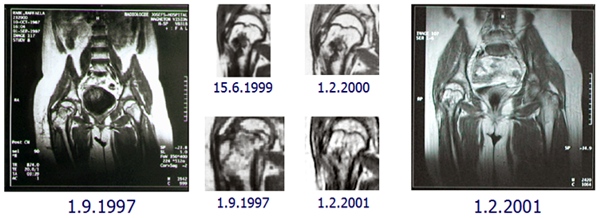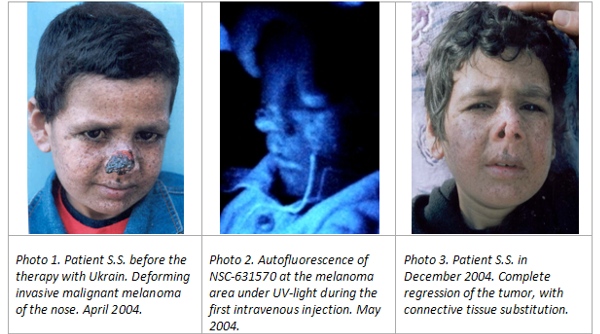- INTRODUCTION: THE FIRST MEDICAMENT THAT KILLS CANCER CELLS BUT NOT HEALTHY CELLS
- I. EFFICACY
- II. SAFETY
- III. QUALITY
- BIBLIOGRAPHY
CASE REPORTS
Besides clinical studies, NSC 631570 has been also used by many physicians in the treatment of various tumors, for example cervical cancer (96), ovarian cancer (97), testicular cancer (98), esophageal carcinoma (99), urethral carcinoma (100), and neuroblastoma (116). Such reports complete the pattern of the clinical using NSC 631570.
Physicians report on the successful treatment of a stage IV breast cancer patient. After the NSC 631570 therapy the tumor size decreased and the surgical removal was alleviated (162).
There are also more reports on the successful treatment of breast cancer (94, 95), including a relapsing breast carcinoma with lung metastases (94).
Beside common solid cancers, infrequent sarcomas present a real problem in oncology because of therapy resistance (93). All the more interesting is the case of retroperitoneal sarcoma successfully treated with NSC 631570. At the time of the publication, e.g. four years after the start of the NSC 631570 therapy, the patient was in full remission (163).
The Ewing’s sarcoma is a tumor from connective tissue cells of bone marrow. It is a rare disease with the incidence of 3 new cases per million. Ewing sarcoma can occur on every site of skeleton. In most cases, legs, pelvic bone, scapula and ribs are concerned. Usually, children between 10-15 years suffer from it, but also children under 10 years can be affected.
A 9 year-old girl from Poland was diagnosed with Ewing's sarcoma. The girl received chemotherapy and radiotherapy but the tumour growth could not be stopped. The girl was declared to have exhausted all possible forms of treatment (i.e. had been given up by mainstream medicine) and was sent home with infaust prospects. The parents took their daughter to Vienna to St. Anna Children Hospital because they hoped to receive the state-of-the-art treatment. The doctors carried out new examinations and had to declare that they too could not help her. The complete repertoire of mainstream medicine was used up but the tumour growth continued. At this point her parents heard about Ukrain by chance and contacted Dr. Wassil Nowicky. On 21 January 1984 treatment with Ukrain was begun.
After six months of treatment with Ukrain the girl was examined again at St. Anna Children's Hospital and to the great astonishment of the doctors not only had the tumour growth been stopped but even better, the tumour had become smaller. However, there was still no interest in Ukrain.
Treatment with Ukrain was continued and every six months the progression of the disease was checked at St. Anna Children's Hospital at the instigation of Dr. Nowicky. In this way Dr. Nowicky wanted to arouse the interest of doctors in Ukrain (unfortunately to no avail).
Gradually the tumour disappeared completely and at the X-ray examination on October 31, 1990 it was seen that even the bone which had been eaten away had regenerated (28).
Ewing’s sarcoma, first diagnosed 22.11.1983, histologically verified, tumour resistant both to chemotherapy and radiotherapy. UKRAIN therapy started on 21 January 1984.

A 9 year-old girl had felt marked pain below the right knee joint in November 1983 following a slight injury. X-ray revealed Ewing’s sarcoma in the proximal portion of the right fibula. Hospital treatment included chemotherapy and cobalt therapy. X-rays confirmed that the patient’s tumour had not responded to radiation or chemotherapy and the tumour mass increased rapidly. One month after the end of chemotherapy, UKRAIN treatment was started at a dose of 5 mg i.m. for a total of 10 injections, combined with regional deep hyperthermia. The first series of UKRAIN therapy included three identical courses with a two-week pause between them. Six series of UKRAIN treatment were administered over the course of one year. Repeated x-rays showed reduction of the tumour mass.
In a 10 year girl the Ewing’s was verified histologically. She was treated in the high risk group of the EICESS 92 study. The MRI of the pelvis revealed the disease progression; the tumor was resistant to chemotherapy and to radiotherapy as well. The treatment with NSC 631570 was started: 15 mg mixed with 250 ml dextrose 5% and 5 g vitamin C followed by local hyperthermia on alternate days, 10 sessions totally. The control MRI revealed the stop of the progression. The followed therapy cycles brought about the regression of the tumor. At the MRI after four years no signs of a relapse or metastases could be revealed (115).
The patient is in remission till now.
Ewing’s sarcoma, first diagnosed 18.3.1996; the tumour was resistant to both chemotherapy and radiotherapy. UKRAIN therapy started on 13 October 1997 (115).

The patient, a 10 year-old girl, was treated in the high-risk arm of the EICESS 92 study. MRI examination of the pelvic region on 1.9.1997 showed progression in the cystic-edematous process. She was then treated with combined Ukrain and local hyperthermia therapy. The therapy series consisted of 15 mg Ukrain in an infusion with 250 ml glucose and 5 g vitamin C, followed by local hyperthermia treatment. Treatment was administered every second day up to a total of 10 therapy sessions. MRI examination on 8.1.1998 showed no progression of the tumour. Subsequent therapy cycles caused regression of the tumour (see MRI on 15.6.1999 and 1.2.2000). MRI on 1.2.2001: Cystic residual defect in right femur, as observed in previous examinations.
No sign of a relapse or of metastases.
Now this former patient works as a nurse in Germany.
In vitro studies (studies on cell cultures) by scientists at the University of Tübingen have demonstrated the effectiveness of Ukrain with Ewing's sarcoma. These studies and clinical successes, such as with Dr. Aschhoff, were repeatedly submitted to the Ministry of Health. At Dr. Aschhoff's clinic ‘Cancer patients were treated whose disease had already been treated with all mainstream medicine therapy protocols and as a result of relapse and/or progress of the disease no further mode of therapy was available for them and who had thus exhausted all modes of therapy’ (161). In these patients, Dr. Aschhoff achieved high remission rate using NSC 631570, for example, 50% for Ewing's sarcoma.
NSC 631570 has been used for the treatment of renal cell cancer after the therapy with vinblastin had failed and the tumor had spread metastases. Full remission was achieved with Ukrain therapy and lasted 32 months at the time of publication (164).
NSC 631570 has been used in the combined treatment of a nonseminoma patient and improved his immune parameters (98).
The therapy of an esophagus carcinoma patient with NSC 631570 induced a prolonged remission (99).
Bladder cancer (urothelial cell carcinoma)
A case of a successful treatment of urothelial cell carcinoma was described. The authors reported on a sustained remission and improved quality of life of the patient (100).
After chemotherapie had failed, the patient was treated with NSC 631570. The tumor markers decreased, the metastases responded well on the therapy and the quality of life of the patient improved (116).
Tuberous sclerosis
As an example of the using NSC 631570 in hereditary diseases, a case of a girl with tuberous sclerosis can be considered. After successful treatment the patient is now an adult woman and has given birth to a healthy son (210).
Generalised lymphangiomatosis
Another publication reports on the successful treatment of a severe hereditary disease generalised lymphangiomatosis (211). The three year-old Stefan Dan with the diagnosis of generalised lymphangiomatosis was sent home by doctors in 1995 as having exhausted all forms of therapy. To “comfort” his parents they were told that Stefan would never be able to speak and walk in his life. After two years of UKRAIN therapy with a general practitioner the child was most certainly able to speak and also to walk. However, treatment with UKRAIN was stopped. The tumour then began to grow and brought about a compression of the spinal cord. Stefan – in the meantime eight years-old – underwent surgery. Despite the surgical intervention the condition of the young patient deteriorated continually, resulting in him having to be connected to a lung ventilator. Paraplegia appeared. In this condition the child was discharged to be cared for at home. He had to be given morphine four times a day to relieve his pain and his breathing had to be supported with a home respirator. The doctors then after all recommended his parents to turn to UKRAIN therapy again. Although the child’s condition could be improved with UKRAIN therapy, Stefan can speak, read, is very intelligent, but will no longer be able to walk.
Xeroderma pigmentosum
Xeroderma pigmentosum (XP) is a genetic disorder of DNA repair in which the ability to repair damage caused by ultraviolet (UV) light is deficient. Multiple basal cell carcinomas (basaliomas) and other skin malignancies frequently occur at a young age in those with XP. In fact, metastatic malignant melanoma and squamous cell carcinoma are the two most common causes of death in XP victims.
This is a very rare disease. The incidence differs regionally and is between 1:40000 (Japan) and 1:250000 (USA). About 250 XP patients live in the USA, about 50 in Germany, mostly children. The life expectance is low; usually they die in the first decade. If left unchecked, damage caused by UV light can cause mutations in individual cells DNA. XP patients are at a high risk (more than 2000 times over the general population) for developing skin cancers, such as basal cell carcinoma, for this reason.
A report on the successful using NSC 631570 in a XP patient suggests this drug can be very useful also in this hereditary disease (212).
Ukrain (NSC-631570) bei Xeroderma pigmentosum
Patient S.S., an eight year old boy, was presented with an ulcering lesion of the nose. As he was 10 month old, xeroderma pigmentosum was diagnosed. Until the age of three years the number of skin lesions increased considerably. In May 2002 skin cancer (squamous cell carcinoma) at the nose was diagnosed, T4NXM0, histologically verified. From May till June 2002 three cycles of chemotherapy were administered (cyclophosphamide, vincristine, and vinblastine). The therapy failed and the tumors grew up. Clinical investigation in April 2004 revealed deforming malignant melanoma of the nose with invasion into the cartilage of nasal septum, measuring 3x3 cm. On 20 May 2004 the therapy with Ukrain was started, 5 mg intravenously twice a week, up to a total dose of 85 mg. One month after the last administration of Ukrain a complete regression of the tumor was revealed. The skin defect was partially replaced with connective tissue. Xeroderma skin lesions improved throughout the body.

